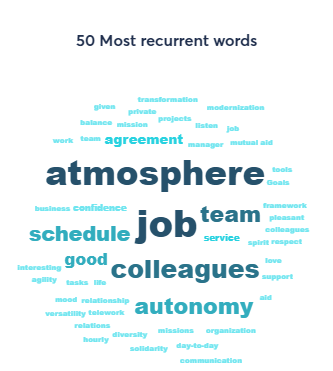In order for comments to add real value to the analysis & interpretation of survey results, a simple and effective tool is essential. Find out in this article how to make the most of your survey results.
Whilst numbers can seem cold, words add depth to the interpretation of results, providing qualitative data to complement the statistics. As well as giving employees the opportunity to express themselves in their own words, survey comments also allow organisations to gather novel insights into potential problems.
However, once collated, all these comments, all this qualitative data, is redundant if we are not well equipped to analyse and interpret it.
Analysing survey comments by hand is an extremely laborious, time-consuming and subjective process. Condensing what could be thousands of comments into a readable amount of information requires some help.
Natural Language processing (NLP) in Zest
In short, NLP concerns training computers to “understand” the content of a piece of text. This field of research is at the intersection between machine learning and linguistics.
Concretely, Zest uses NLP to automatically analyse comments in two different ways:
-
Word clouds
This method produces a clear representation which shows the occurrence of specific words in a visual and comprehensible way. In this word cloud, the colour and size of a word is represented proportionally to its frequency of occurrence within survey comments. Consequently, this tool allows you to concentrate on the key subjects, which have been expressed by employees in their own words.
For example:
- The things I most appreciate in my life at work (3 major points).
Analyse multiple languages…
Furthermore, this feature also allows comments in different languages to be processed and analysed using a shared database. Practically speaking, this means that Zest has the capacity to analyse and compare all comments, whatever language they may be written in. This is of course a huge advantage to multinational organisations or those with a diverse workforce who work in many different languages.
-
Sentiment analysis
The other method of analysis, which is also automatic in Zest, is the affectivity score. This score gives a percentage of the positivity of words chosen by participants and, as such, helps to interpret the overall feeling of employees regarding this question. Do employees react in a more or less positive way regarding a particular question ? The affectivity score will tell you !
To go even further…
In addition to these methods of analysis, which are automatically available online & in the app, Zest offers an additional support service to delve deeper into the interpretation of your survey comments.
-
Mapping
Without having to read each comment individually, this method aids the interpretation of associations between words making up comments by visualising these connections and their strength. For example, when employees talk about the relationship with their manager, what words come next?
-
Clustering
This method groups the most used words (for example those which appear in the word cloud) according to a particular theme to create “clusters”. Through the use of dendrograms, relationships between sets of data are visualised, enabling a deeper interpretation of results regarding the key subjects for your employees.







